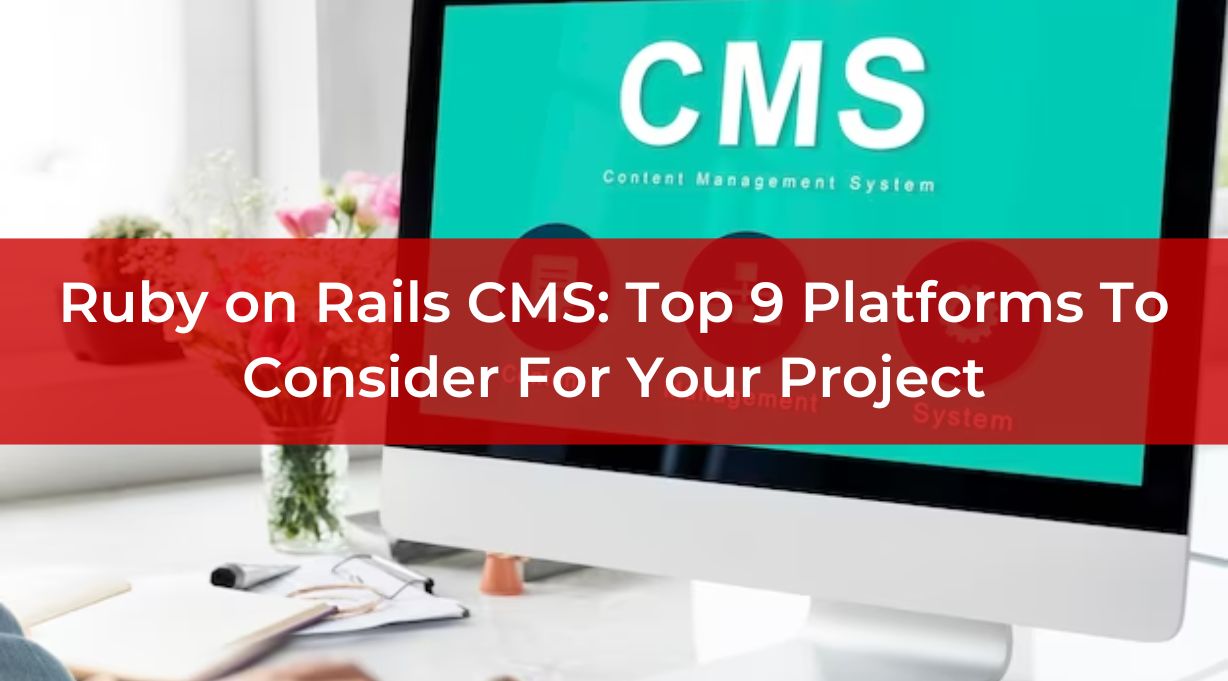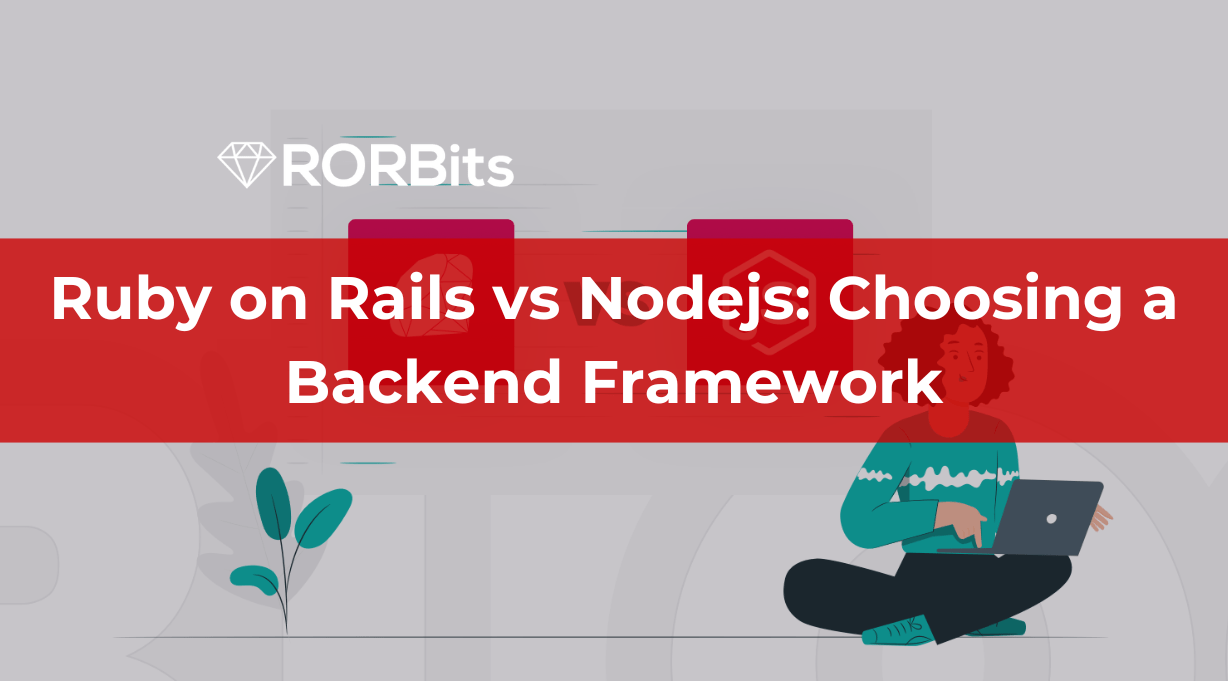Ruby on Rails CMS platforms are meant to simplify the web development process. Hence, it’s crucial to know about Rails CMS.
May you have a development team for working on your ruby on rails projects, and it’s great to have them.
They will manage your things precisely, they will write an effective code for your project, and put efforts to make your site attractive and unique.
Still sometimes, it all becomes complicated for your project, especially when you want your website simple and smaller.
And here, the role of ruby on rails CMS comes to play. By acquiring CMS platforms you can drive your website into fast development with less effort.
This blog is dedicated to help you make a wiser choice for Ruby on Rails CMS. Let’s begin to understand everything about CMS with great examples.
What Is Ruby on Rails CMS?
Ruby on Rails is a backend framework in web development. Rails is written in the Ruby programming language.
Rails is an open-source framework created under the MIT license.
Developers utilize JSON and XML to simplify data interchange in support of Ruby on Rails.
Ruby on Rails expedites development, enabling developers to focus more on the most recent advancements for the internet application.
And it works on two major principles, one is Don’t Repeat Yourself (DRY) and other is Convention Over Configuration (COC).
On the other hand, CMS is referred to as a Content Management System. It is a software platform that helps in user creation, user management, and digital content modification required for web development.
Different multimedia content like graphic designs, images, videos, animations, written content, everything is managed by CMS software without the requirement of any underlying code interactions.
In simple terms, Content Management System (CMS) is a software platform which simplifies the website development procedure by enabling edit, manage, and create web content to you without any demand of coding knowledge.
Hence, Ruby on Rails CMS is a software platform which allows all the modification with Rails framework needed during the web development process.
If you are thinking of initiating a ruby on rails development project, then we suggest you connect with any of the best custom ruby on rails development services such as RORBits, So you will get better outcomes in future.
Importance Of Ruby on Rails CMS
There are several reasons to consider and use ruby on rails CMS. Let’s explore the seven prime reasons of why ruby on rails CMS are important:
1. User-Friendly Features
Ruby on Rails CMS is always simple to use and that makes it a great user-friendly software platform.
It allows any registered or approved user to modify things like editing files, uploading online images and texts, having or not having any development experience.
With CMS, it is simple to change, delete, and distribute site content as well as receive updates.
2. Any Business Size Are Invited
Doesn’t matter if you are a startup or belong to any well-settled business, Ruby on Rails CMS allows any organization to smoothly place their content on a website.
And that web content helps them to generate huge traffic on the website, ultimately generating high revenue. Simply, It provides solutions that are simple, scalable, flexible, and affordable.
3. Quick Content Updation
A CMS user can edit, modify, or create their material instantly without waiting for a webmaster or developer to sort out the changes. Contents may always be current and fresh with CMS.
4. Enhance Collaboration And Sharing
A collaborative atmosphere is offered by ruby on rails CMS for content sharing, that helps to enhance communication and is worthwhile to process management, data automation, and workflow.
5. Accessed At Any Location
The prevalence of remote work has increased, and CMS has emerged as the most practical feature by making website material essentially accessible from anywhere using any connected computer device that has Internet.
6. Simple And Fast Integration
Through your website, content integration becomes easy and quick with ruby on rails CMS.
In contrast to static websites, content management system sites heavily integrate dynamic web content, allowing for the updating and regenerating of material as needed.
When using a CMS, your data is not coded into easily maintainable website pages but rather pulled from databases.
7. Improved Security And Custom Permissions
High security features are installed in ruby on rails CMS platforms. The system also offers website access management, allowing you to assign users to certain areas of your website or limit their access to specific information or portions.
How To Select The Appropriate Ruby on Rails CMS Platform?
Until Now, we have discussed the What Ruby on Rails CMS and the importance of having ROR CMS.
Let’s explore the factors you should consider depending on your goals for web development while selecting the best platform to use.
1. Business Match
Always consider the platform which fulfills your business requirements and completely suits your business idea.
You have to look out for all the features offered by CMS such as configurability, optimization tools, etc.
Having a proper idea regarding your dream project can assist you well in choosing the right CMS platform for your business.
2. Ease of Use
Having an easy-to-use CMS platform is crucial. It allows you more time to embrace content in your web application.
Check out the features and filter those CMS that didn’t ask for any complex coding experience to work on.
3. Performance
Look at how each CMS platform functions.
Some offer interactive CMS for dynamic websites, offline data processing for status websites, and hybrid CMS that combines static and hybrid functionalities.
Each platform’s performance during the creation of web applications is determined by these functionalities.
4. Usability
Simple usability is important to experience a great development process. Consider features like a user-friendly interface, multilingual support, responsiveness of the program, launch speed, etc.
5. Security
You have the option of selecting closed-source or premium CMS platforms with top-notch security features, depending on the kind of content you manage.
Analyze your resource’s vulnerability to cyberattacks and data breaches, and determine whether a breach would be disastrous for both your users and your organization.
6. Scalability
As per your business model, determine your requirements regarding scalability. You might need to adopt a more elaborate and comprehensive CMS platform if your business model is complex and highly scalable.
At the same time, you should choose a less sophisticated or non-technical CMS for straightforward websites and static pages.
7. Optimization
To rank your website up among all the competitors, it is essential to keep up with industry standards.
You can maintain your brand’s position at the top of the search results by making an investment in CMS platforms that offer SEO and other cutting-edge functions.
8. Support and Maintenance
Look for the update and maintenance frequency of the ruby on rails CMS. Check the number of documentation available. This step will ensure that you have all the required resources to guide you during any technical issue.
Let’s explore the best 9 ROR CMS used for web development.
Top 9 Ruby on Rails CMS For Web Developers
We have experience with Rails CMS and technologies as an expert ruby on rails developers.
Here are the top six RoR CMSs that you can use for your upcoming online project.
These CMS platforms present a range of advanced features and are meticulously crafted for Ruby on Rails development.
| ROR CMS | LICENSE | DOWNLOADS | GITHUB STARS |
| Refinery | MIT | 7,99,709 | 3.7K |
| Locomotive | MIT | 1,67,338 | 2.3K |
| Camaleon | MIT | 1,33,917 | 1.1K |
| Alchemy | BSD-3 Clause | 3,96,782 | 732 |
| ComfortableMexicanSofa | MIT | 10,60,026 | 2.7K |
| Spina | MIT | 63,393 | 1.8K |
| Radiant | MIT | 1,56,141 | 1.6K |
| Fae | MIT | 31,419 | 710 |
| Browser | LGPL-3.0 | 2,00,000 | 1.2K |
1. Refinery CMS
Refinery CMS, one of the industry’s leading RoR CMS platforms, is a free, open-source RoR online application that uses JQuery as its JavaScript library.
Initially, David Jones created Refinery CMS as a closed-source project for Resolve Digital in 2004. Later, in May 2009, it was unveiled as open-source software under the MIT License.

Essential Features of Refinery CMS:
- Built in text editor
- Built-in calendar sync and image editor
- possibilities for modifying search indexes
- easily modular and expandable
- more than 30 languages are supported
- Tools for SEO optimization like SEO-friendly URLs
- supporting image galleries
- mechanism for navigating trees
- many extensions
Advantages & Disadvantages of Refinery CMS:
Advantages:
- It uses a straightforward and adaptable method for web building
- Regular updates include the newest extensions
- for non-technical end users to use
- greater than 400 authors
- easy-to-use interface
Disadvantages:
- For projects requiring intricate routing and dynamic web pages, it can be too simplistic.
- imposes a specific web page layout. Website designs that are intricate and original cannot be made here.
Where Can Refinery CMS Be Used?
Developers of e-Commerce websites and online apps who want a straightforward function and design can consider Refinery CMS.
2. Locomotive CMS
Commercial software called Locomotive CMS is available in both free and paid editions.
To enable developers to concentrate on frontend technologies, achieve a standardized development process, and experience an accessible learning curve, Locomotive was developed.

Essential Features of Locomotive CMS:
- Support for many sites natively
- Uses the easy-to-use and clean templating language – Liquid
- It is simple to build new sections and content types. No need for SQL
- An appealing and simple editing interface
- able to fully localize all pages and content
- embed a RESTful API to control each website
- Utilizing your preferred tools, create and preview websites locally (Wagon)
- Support for CoffeeScript (Wagon), Webpack, SASS, and HAML
Advantages & Disadvantages of Locomotive CMS:
Advantages:
- Both free and paid versions are available, including website hosting
- Instantaneous editing
- Offers a line preview
- Active Neighborhood
- Up-to-date Documentation
Disadvantages:
- Only works with non-relational databases
- Limited with CLI-Wagon
Where Can Locomotive CMS Be Used?
Locomotive is the best option for developers working with NoSQL databases, people who need to manage several RoR websites, and people searching for a platform that is similar to a blog engine.
A clean interface and a straightforward, practical design are also provided.
3. Camaleon CMS
Camaleon CMS is another excellent option for RoR content management systems. Additionally, it is a CMS that is open-source, free, and customizable.

It is a browser-based CMS that offers a distinctive selection of plugins, widgets, and reusable templates. For RoR developers who want to manage complex content much more easily, it is a strong WordPress substitute.
Essential Features of Camaleon CMS:
- Shortcodes
- Widgets
- Sortable, drag-and-drop, and multi-level menus
- Layouts/Templates for pages
- Specialized user roles
- Built-in local and Amazon S3 support for file uploads
- Simple conversion from older WordPress Sitemap generations
- Configuring SEO
- For social media, SEO
Advantages & Disadvantages of Camaleon CMS:
Advantages:
- It is expandable and modular
- Open to third-party plugins for further features
- Websites only require one installation
- Simple to use and learn
- Drag and drop personalization options
Disadvantages:
- Problems and issues are not promptly fixed
- Small community
- Little linguistic support
- Unable to support web projects in several languages
Where Can Camaleon CMS Be Used?
Camaleon CMS is perfect for tasks requiring rapid web development.
It is useful for individuals who want WordPress-like functionality and need scalable web pages that can support lots of visitors.
4. Alchemy CMS
The open-source RoR CMS platform Alchemy CMS has a unique method of content management.
It is well-known for its logical segmentation of pages into categories such as headlines, paragraphs, graphics, and more.

Essential Features of Alchemy CMS:
- Flexible templating that distinguishes between markup and content
- A robust API
- Live preview and intuitive admin interface
- SEO-friendly URLs with multi-language and multi-domain Page versioning
- User Access Management
- Mailer for contact forms built-in
- Added files and downloads
- Image scaling and cropping on the fly
- Using the Rails engines extensible
- Combines with current Rails apps
- Extensive Rails admin features
- Adaptable caching
Advantages & Disadvantages of Alchemy CMS:
Advantages:
- Intricacy and simplicity in harmony
- Documentation that is thorough and simple to grasp
- Able to create scalable websites
- Ideal for large-scale, complex projects with cutting-edge functionality
Disadvantages:
- Setting up and customizing can be time-consuming
- Not user-friendly for those with little or no IT expertise
Where Can Alchemy CMS Be Used?
Developers seeking to create intricate and unique layouts for their websites should opt for using Alchemy CMS.
Additionally, it is perfect for use by teams of seasoned developers and those looking to harness the full potential of RoR CMS applications.
5. ComfortableMexicanSofa
ComfortableMexicanSofa is another CMS engine that differs from the standard RoR CMS collection. It offers robust features and is well-liked by the RoR CMS community.
Within weeks of its publication, its popularity soared despite the lack of a website.

Essential Features of ComfortableMexicanSofa CMS:
- Minimally configured simple drop-in integration for Rails 5.2+ apps
- CMS keeps the rest of your application separate
- The ability to create powerful page templates utilizing content tags
- From a single installation, multiple sites
- Support for Multiple Languages (I18n Gem)
- CMS seeds for the first population of content
- Revision History to undo modifications
- Bootstrap 4 was used to build the extensible admin area (responsive design).
Advantages & Disadvantages of ComfortableMexicanSofa CMS:
Advantages:
- Several websites can be managed with a single installation
- Layout mirroring functions more like a RoR app than a separate CMS
- Community expands
- CMS code is kept separate from web app development
Disadvantages:
- Slope of learning
- For beginner developers only
- Need understanding of HTML
Where Can ComfortableMexicanSofa CMS Be Used?
For seasoned web developers who desire some flexibility and are willing to learn new technologies, this CMS engine is great.
Small development teams aiming to handle multiple websites with similar layouts can also employ this CMS.
6. Spina CMS
The goal of the user-friendly interface of this relatively new open-source RoR content management system is simplicity.
Despite having any experience with HTML, CSS, or web setups, Spina CMS enables developers to take full advantage of its features.

Essential Features of Spina CMS:
- The eight built-in elements available for creating pages include Line, Multiline, Text, Image, Image Collection, Attachment, Option, and Repeater.
- Themes offer several view templates, create a homepage, and by default display templates
- Layout elements
- Trix is the editor it uses by default
- PostgreSQL is used by custom pages
Advantages & Disadvantages of Spina CMS:
Advantages:
- Updated frequently and employs the newest Rails versions
- No Webpacker
- Not SEO friendly
- There is no demand for HTML or CSS
Disadvantages:
- Inadequate documentation
- In the admin panel, managing numerous sites is not possible.
Where Can Spina CMS Be Used?
Spina CMS is ideal for developers that wish to use SEO optimization, concentrate on it, and drive substantial traffic to their websites.
This CMS should be utilized exclusively by individuals who intend to manage a maximum of 2-3 websites, as it enforces limitations on the number of websites that can be handled.
7. Radiant CMS
The first CMS designed for Ruby on Rails is called Radiant CMS.
Built in 2006, it now has more than 200 additions. Its accessibility and extensibility are partly responsible for its popularity even now.

Essential Features of Radiant CMS:
- It uses Radius, a custom template language
- Supports the languages of Textile, Markdown, and HTML
- Possesses a cutting-edge page caching system
- Manage various content kinds, including PDFs, Docs, Images, and Videos, using only 4 easy tabs
- Clutter-free, basic UI
- Packs of native languages
Advantages & Disadvantages of Radiant CMS:
Advantages:
- The intention is to enhance developer productivity and reduce distractions through a simple user interface.
- Support for several formats
- Native language translation tools for your website
- extremely simple, with the ability to extend functionality through plugins
Disadvantages:
- The business no longer makes new versions
- need familiarity with HTML, JavaScript, and markup languages
- Not updated in the previous five years
Where Can Radiant CMS Be Used?
- Small-scale Ruby on Rails initiatives
- Single-page websites
- Projects that don’t call for frequent content updates
8. Fae CMS
The relatively new RoR CMS Fae makes the claim to be unique and superior to others. Due to the fact that it functions similarly to Ruby on Rails, many Ruby programmers have started utilizing it.
The content management system (CMS) employs the MVC design pattern to manage content. This CMS separates the code into distinct layers: the model, controller, and view.

Essential Features of Fae CMS:
- User identification and approval
- An elegant interface
- Assistance and validations for forms
- Processing images
- Managing various work processes
Advantages & Disadvantages of Fae CMS:
Advantages:
- Models, Views, and Controllers are used
- Streamlined user experience
- Available with complete customisation
- Closely relates to Rails
- Automated bug-fixing
Disadvantages:
- There aren’t many examples of Rails projects accessible
- Extremely new and lacking a vibrant community
- An understanding of how the MVC framework works
Where Can Fae CMS Be Used?
- Working with models and views, MVC – Ruby on Rails architecture, is what you enjoy
- Websites must require classes and inheritance
- Little projects
- Single-page programs
9. Browser CMS
You get a ton of editors and a sizable number of strong core capabilities with BrowserCMS. The system also supports several modules and various authorization models. BrowserCMS is hence quite adaptable.
It offers extendable content API and adjustable permissions, is RoR 3.2 compatible, and allows immediate in context editing. Additionally, information can be arranged according to Type or Sitemap.

Essential Features of Browser CMS:
- To facilitate the content management procedure, this CMS offers Sitemap which provides the convenient format for searching (a la Explorer).
- Browser CMS has CRUD (Create, Read, Update, Delete) interface to deal with multiple types of content.
- Section Focused Security is also a feature of this CMS which allows administration to give access to someone for certain resource pages.
- Advanced caching of web pages can enhance the efficiency of the Browser CMS platform.
Advantages & Disadvantages of Browser CMS:
Advantages:
- It offers a customizable and multilevel access system in which a unique group of users gets various types of access and rights to work with the Ruby on Rails CMS platform.
- It has a highly intuitive interface which is easy to use and a very convenient user-interface.
- The most worthy advantage of this CMS platform is it has mobile responsiveness.
Disadvantages:
- Not so popular as compared to other ruby on rails CMS platforms.
Where Can Browser CMS Be Used?
Simpler and small websites who want easy navigation and functions can consider Browser CMS.
Conclusion
Using a CMS streamlines content management and simplifies development for your Rails website project.
For varied uses, there are many content management systems available. Each has exceptional qualities, so it’s up to you to decide which is best for your project.
Still baffled? For more information on various content management systems, speak with RORBits – ruby on rails consulting expert. Using Ruby on Rails, we create specialized web solutions.
For any Rails development project, our staff will make sure you receive the greatest support and assist you in selecting the appropriate CMS.




